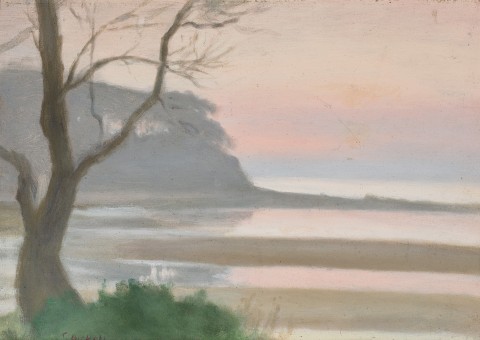BEAUMARIS SUNSET, c.1928 – 32
CLARICE BECKETT
oil on pulpboard
29.5 x 41.5 cm
signed lower left: C. Beckett
Private collection
Leonard Joel, Melbourne, 28 July 1998, lot 154
Private collection, Melbourne
Lauraine Diggins Fine Art, Melbourne (label attached verso)
Private collection, Canberra, acquired from the above in 1999
Annual Collectors’ Exhibition 1999, Lauraine Diggins Fine Art, Melbourne, 5 June – 3 July 1999, cat. 38 (illus. in exhibition catalogue)
Clarice Beckett is renowned for her sustained, early modernist vision of Melbourne, particularly focussed on the coastline near her home in the Bayside suburb of Beaumaris. When asked why she never desired to travel overseas, she replied ‘I have only just got the hang of painting Beaumaris after all these years, why should I go somewhere else strange to paint?’1 Beaumaris sunset is a wonderful example of her work, featuring the rugged coast at the end of Dalgetty Street, where the artist lived. The upper layers of the headland are comprised of Black Rock sandstone which have eroded over time to reveal the lower basalt level. Middens and hand-dug wells from the Bunurong people remain in clear evidence along the cliff’s base, as does a plethora of important marine fossils in the shallow waters offshore (now protected). The headland and its near neighbours also feature in such notable works as Tom Roberts’ Slumbering sea, Mentone, 1887 (National Gallery of Australia); and Arthur Streeton’s Fossil bay, flood tide, 1925 (private collection). In Beckett’s view, the falling light of sunset and the mirrored surface of the still waters emphasise the brooding aspect of the headland, with the lone tree to the left recalling the composition of Japanese woodblock prints. A small number of her works feature similarly placed trees, such as View across the Yarra to Government House, c.1931, and Trees beside the Yarra River, c.1925.2
Beckett was raised in Casterton in regional Victoria but the family often holidayed at Beaumaris. Her mother Kate ‘had taken sketching and painting classes and counted among her friends Walter Withers and Ola Cohn.’3 On their advice, she enrolled Clarice (and her sister Hilda) in National Gallery School in 1914, studying under Frederick McCubbin. Inspired later by a lecture by the artist-theorist Max Meldrum, she joined his school for a year. Meldrum taught his own theory of ‘optical science’ aka Tonalism, which, as its name implies, revolved around building an image based on tonal values alone. Although she remained within the Meldrumite orbit throughout her subsequent career, Beckett’s paintings were truly a combination of the Gallery School’s academic teaching, Tonalism – and herself. As her colleague Elizabeth Colquhoun noted, Beckett’s paintings were more ‘fragile’ than Meldrum’s. ‘It was a different kind of thing, but it was very truthful.’4
Beckett was prolific and exhibited regularly but struggled to find financial or critical success, even though her talent was celebrated by Meldrum who wrote that she created work ‘of which any nation could be proud.’5 Beckett’s fame has since increased to such an extent that almost every one of the country’s major institutions now own examples of her work. She was, in the words of the artist Sir William Dargie, ‘a pure and perfect artist in her own way, one of the finest ever to work in Australia.’6
1. Hollinrake, R., Clarice Beckett: the artist and her circle, Macmillan, Melbourne, 1979, p. 21
2. View Across the Yarra Towards Government House, c.1931, oil on board, 25.5 x 35.5 cm, Deutscher and Hackett, Twenty Important Women Artists + Selected Australian and International Fine Art, Melbourne, 10 November 2021, lot 9; Trees beside the Yarra River, c.1925, oil on pulpboard, 25 x 35.5 cm, Deutscher and Hackett, Important Australian + International Fine Art, Sydney, 14 September 2022, lot 77
3. Hollinrake, R., ‘Painting against the tide’, The Age, Melbourne, 3 April 1985, p. 16
4. Elizabeth Colquhoun, cited in Juliet Peers, More than just gumtrees: a personal, social and artistic history of the Melbourne Society of Women Painters and Sculptors, Dawn Revival Press, Melbourne, 1993, p. 197
5. Max Meldrum, cited in ‘Work of Clarice Beckett’, The Age, 5 May 1936, p. 9
6. Dargie, Sir W., ‘Introduction’ in Homage to Clarice Beckett (1887 – 1935): Idylls of Melbourne and Beaumaris, Rosalind Humphries Galleries, Melbourne, 1971
ANDREW GAYNOR
